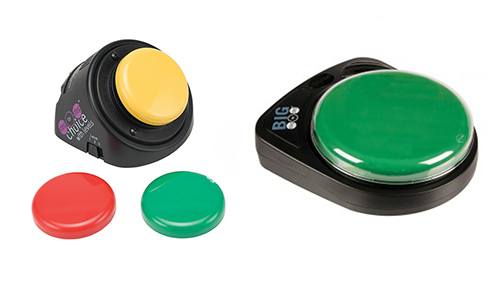Introduction
When developing personalized augmentative and alternative communication (AAC) systems, curriculum, and instruction, it is important to know about the daily life experiences of students beyond the school setting, including the interests, language, and ideas that are valued at home. However, it can be an ongoing challenge for teachers and school-based speech and language pathologists to learn of and, in turn, use this information to regularly update AAC systems and to provide instruction that allows children to share and build upon familiar, motivating experiences, and become increasingly competent communicators.
In this section we discuss how this problem has been approached at The Bridge School using a regular feature of our program that we call Home News. Case examples illustrate how Home News is used to support students’ ability to share news-worthy experiences from their home environments, expand AAC systems, and to provide instruction specifically targeting individualized goals and objectives across operational, strategic, social, and linguistic competencies. We also describe our process for recording, archiving, and analyzing Home News and provide tip sheets for promoting a family’s selection and recording of Home News to best support and expand their child’s growing communicative competence with AAC.
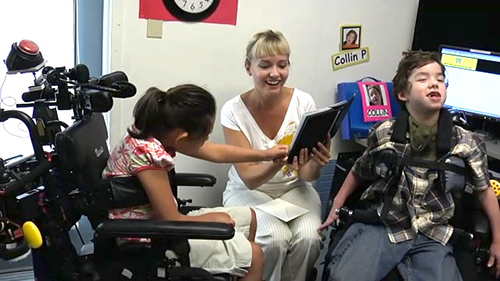
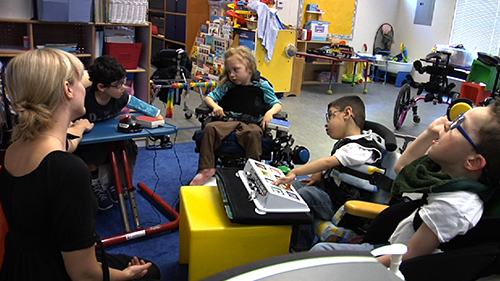

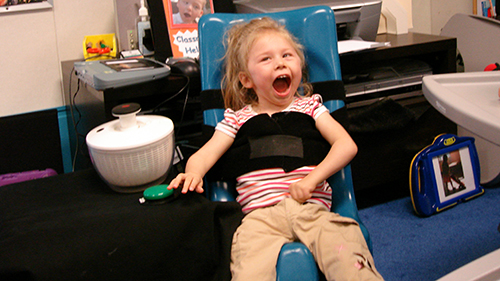
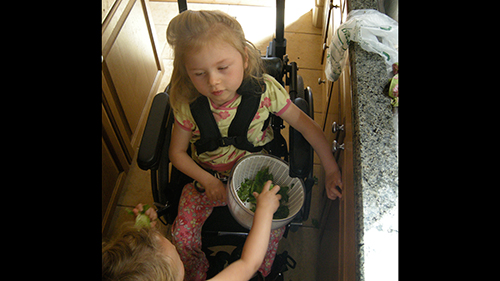
What is Home News?
Home News consists of the routine creation, sharing, and use of digitized recordings of relevant events and experiences from home. Independent of ability levels, students share Home News in similar ways, through the use of a simple digitized, sequenced-message device or other speech-generating device (SGD). Each day, the student and family member collaborate to develop Home News content and then record it as a series of messages to share at school. Sharing Home News at school, in structured small group activities, provides students with daily opportunities to gain communicative competence with AAC tools in various ways. For example, some students are learning to reliably activate a single switch. Others are developing the ability to strategically release spoken messages in supportive social interactions at ‘the right time’ with various communication partners, both peers and adults. Given these regular experiences of recording news at home and sharing news at school, our students can begin to ‘own’ the linguistic content of prerecorded spoken messages and become motivated to incorporate voice output into their repertoire of existing communication abilities in ways that are increasingly meaningful to them.
Our application of Home News goes well beyond the important routines of recording and sharing on a daily basis. Home News offers an ongoing source of relevant and meaningful information that allows us to build upon each student’s familiar experiences, motivation, skills, and interests. By saving and reviewing Home News messages over time, we are able to document experiences and topics of interest for each student, to gain a sense of the language and communication patterns that students are exposed to at home, and to create data sets that are used to identify recurrent linguistic constructions, key vocabulary, and important personal and family topics that may come and go over time. In turn, we use this information as the input for AAC system development and individualized literacy instruction.
Watch a couple video examples of Home News sharing in class
Example One
Example Two
Listen to a few examples of Home News recordings
Preschool student
First Grade Student
Second Grade Student
Middle School Student
Rationale and Purpose
Children gather their experiential knowledge through participation in the activities of the world, including the verbal discourse that swirls around them.
– Katherine Nelson, 2007
How children make sense of what they hear is influenced by what they already know from experience, as well as by the events and circumstances in which they hear it (Nelson, 2007). Given that all learning depends on prior information and experience – what’s meaningful and what is remembered – when developing AAC systems and delivering instruction, we must pay attention to the “swirl of talk” that the students experience at home. Home News is a way to actively engage children with CCN in conversations at home and school as they learn to become increasingly active participants in communicative exchanges.
Although in practice much time is spent teaching children to learn AAC systems, most AAC devices are not designed in ways that are consistent with how children view and experience the world. AAC systems can be difficult for young children to learn and use. Research tells us that AAC systems for young children should be appealing, motivating, and easy to use in context (e.g., Light, Drager & Nemser, 2004; Light, Curran, Page, & Pitkin, 2005).
Sharing Home News with a message sequencing SGD (as a component of the child’s larger, multimodal communication repertoire) is a way to keep AAC highly motivating and fun while reducing physical effort and competing demands for attention and learning.
Research also suggests the use of personalized schematic/thematic vocabulary organization in AAC systems (Fallen, Light, & Achenbach, 2003). Home News provides children with pre-recorded vocabulary that is organized in small groups or sets and according to familiar events.
Three Reasons to Implement a Home News Program
1. Home-school connections
- Home News is a rich source of information to help the school team to activate an individual student’s background knowledge for new learning (help student connect new information with their own prior experiences)
- Source for topics of interest for individualized academic instruction (what the student is interested in based on personal experiences)
2. Source for vocabulary for AAC systems
- Topics of importance and interest are identified within the news that is shared
- Language, wording, and phrasing (the family “dialect”) is heard
- Topics and vocabulary can be saved as a data set
3. Daily opportunities to address specific communication goals
- Communicative Competence skill areas: Operational, Social, Linguistic, Strategic
Preparing
To establish a Home News program in your classroom:
- Send a letter home to parents and caregivers [PDF, 32KB]
- Send the Parent Tip Sheet to parents and caregivers [PDF, 514KB]
- Procure appropriate assistive technology devices
- Determine a time each day for students to share (snack, recess, morning meeting, sharing time, free time, etc.)
For the Parent
Your child will share Home News by releasing spoken messages that have been pre-recorded into a simple digitized sequencing device. This type of device is designed to release pre-recorded spoken messages, in the same order as recorded. You and your child will determine topics/thoughts/ideas. Then, you will speak into the recording device and record the messages for your child’s Home News.
What Device Should I Use?
Many teachers and parents choose to use simple digitized, sequenced-message devices for the recording and sharing of Home News. These devices are a good choice because:
- The sequence of the recording device provides a structure for the messages to be shared.
- Using a recording device with sequential messages can guide your student towards sharing a story, or recount of an experience, from the beginning to the end of the experience.
- Sequential messages also guide a conversational flow with a communication partner, allowing for the quick back-and-forth taking of conversational turns with another person.
- Students who are learning to use alternative access methods for accessing their communication systems (like capability or accessibility switches) can participate.
- To share, the student may activate the surface of the device itself, or they may activate an appropriate switch plugged into the device.
- Because you are recording ‘natural’ speech, the messages are easy to understand and contain all of the extra elements that add meaning to a message, like loudness level, the rhythm of speech, and intonation.
- Because you are using your voice, your child may be particularly motivated to share the news messages and have increased attention while sharing.
Examples of simple digitized, sequenced-message devices:
An iOS or Android device with an appropriate App such as (l-r), GoTalk NOW, Pictello, iTalker, TalkBoard, Talk + Touch, Talk’n Photos
A SuperTalker Progressive Communicator device, using the ‘step-ahead’ jack for single switch sequential message playback.
Some students will use other communication systems to share their Home News. Over time, your student may begin to share in different ways, using different AAC tools. Your child’s teacher, speech-language pathologist, or assistive technology specialist can provide more information on how to record Home News on other devices.
Tutorials
INTRODUCING THE STEP-BY-STEP
WHAT IS THE STEP-BY-STEP
HOW DO WE USE THE STEP-BY-STEP
PROGRAMMING THE STEP-BY-STEP
User manual for Step-by-Step™ devices [PDF, 1.1 MB]
Collaborating and Recording
How to Prepare a Home News Recording
Think and talk with your child about topics that they may want to share with friends at school. Offer your child a few different options for topics. Offer your child options for word choices (how to phrase the messages). Allow your child to choose to omit parts that they do not wish to share, even if you think otherwise. Consider: Was there an activity that he really loved? Something unexpected or silly? A new experience that he wasn’t so crazy about? Any special events that you are talking about at home? Books he read? Fun computer games? Favorite songs? Also decide which aspects of your child’s experience may be relevant to share, such as how they felt about something or their mood or temperament. Consider including sound effects and funny noises that are part of the topic. Brainstorm a list of the messages you will actually record for the Home News.
Tips to Help You Get Started
- Say, “__________, let’s record your ‘news’. What do you want to tell Miss Caitlin and your friends at school?”
- While your child listens, review interests, activities, events, experiences that you think your child would like to share. Pay attention to topics your child may be choosing using eye gaze, body language, and/or pictures.
- For example: “You are looking at the party favor bag! You could tell your friends about the birthday party!”
- Collect any objects, props, photos, or remnants (like a ticket stub), or other objects that will help your student when they share. Label them with your student’s name and send them in to school.
- Include sound effects, short music clips, sibling voices, and other special sounds on the recording, when appropriate.
Conversational Topics for Home News
Anything of interest to your child and your family can become a topic of Home News. The general structure of Home News talk is conversational discourse.
Topic
Examples
Home News Audio Examples
Toys, Books, CDs, Clothes, Games
New build-a-bear, favorite song from a CD, special T-shirt
Experiences, activities, or family outings
Hair cut, birthday party, trip to the zoo, something they really didn’t like (going to the dentist)
Interactions, memorable events, incidents, or special moments shared with family members and friends
Mom’s lost wallet, visit from Uncle Mark
Favorite family games or routines
Hiding from Mom, playing ‘airplane’ with Daddy
A demonstration or description of a procedure
How to do something, or how something was done (baked a cake with mom)
A story someone told them or something they heard on the radio or news program
Uncle Ron telling about his new puppy, local news story about a community fun run.
A recount of a TV episode or scene from a movie
Funny scene from Blue’s Clues, scary scene from a movie
Events coming up in the future
What is happening this weekend or next month, etc.
Events from the past
What happened after school the previous day, or further in the past.
Plans for the future
Planning for a birthday party or holiday event, planning for a visit from a relative or family friend.
Personal experiences related to current school curriculum
Response to school news question: student shares information about where their family members come from
Telling a Joke
Telling Knock-Knock Jokes, describing or recounting a family “inside joke”
To Illustrate
These examples illustrate a variety of ideas to consider when developing Home News recordings.
Description
Audio Examples
Taking the child’s perspective
Notice how these recordings take the perspective of the child sharing Home News with teachers and classmates at school (vs. at the time of the recording).
Incorporating the child’s own voice
Create opportunities for the student to use their own speech, voice and sounds to provide critical information.
Incorporating sound effects
Children are engaged by sounds and love to produce sounds. These examples incorporate sound effects, songs, musical instruments, laughter, or different voices.
Siblings sometimes record Home News
Sometimes, if the student doesn’t mind, siblings participate in preparation of Home News recordings. When a sibling records the Home News in its entirety, the student can share news at school using a familiar, child voice quality (vs. adult).
Using objects and props
Encourages active engagement by allowing classmates to see, touch and maybe even taste or smell the item as it is described in the Home News sequence. During sharing, objects can help focus attention and engagement of classmates as the sequence of messages is revealed. Visually shared referents may allow communication partners equal access to the referent for commenting and providing communication support.
Demonstrations
Sometimes the child’s Home News contributions include active “demonstrations” of a noise, or reaction, or toy, or song. (AA wii bowling)
Students can demonstrate actions or sounds at the appropriate point when sharing at school. Enacting or demonstrating aspects of the Home News content may help children become more aware of the audience or enhance their delivery of recorded news with gestures and vocalizations.
Timing and phrasing
(JS haircut) The series is organized and recorded in small groups or sets and according to the events.
Sharing
Preschool Program: “Guess What I Have?”
In Preschool, Home News takes place during a structured sharing time daily and looks a lot like other Show and Tell times in preschool and transitional Kindergarten (TK) classrooms.
Children bring in an item such as in a toy, a book, a photograph, or some other meaningful object to share each week. Sometimes students bring an item related to the current theme. Families record the message about the item, and students tell and often re-tell the recorded Home News message during sharing time. During the week, the teacher and/or Speech-Language Pathologist often takes photographs of the shared object so that they can be used a selection for writing or a conversation. She may also ask classroom staff to write down key phrases, topics, people, places, and other relevant information about what is shared.
The teacher and speech-language pathologist keeps a record of how the student shared, including collecting observational data on a student’s communication goals.
Elementary Program: “Guess What I Did?”
In the Elementary Program, Home News is often shared during a Morning Meeting time as well as informally during the school day. Many students enjoy sharing their Home News recordings multiple times during a single day, with different communication partners.
Students use a range of AAC tools to communicate and participate in the school day. The device used to share Home News is one component of a set of communication tools. It is accessible to students throughout the day, for easy access to sharing again when another opportunity arises. Teachers find it helpful to mount the device onto the student’s wheelchair, or designate a visible, permanent space within the classroom to place the Home News devices so students and staff can easily access them.
Building Communicative Competence
Home News sharing time is one opportunity in a school day where a variety of communication goals can be addressed. Different students can work on developing different skills within the same daily routine.
For more information, check out the module on Communicative Competence.
Sample Goals
Operational Skills
- Plan, sequence, and produce body movements to act out messages via pantomime (e.g., to communicate swimming, sleeping, jumping)
- Demonstrate consistent volitional control with a predictable response time to:
- Activate a single switch
- Activate one switch from 2 or more switches to produce the same response (split-switch)
- Activate a switch multiple times to release a series of pre-recorded messages
Strategic Skills
- Use mementos/remnants to bypass vocabulary limitations and establish topics of interaction.
- Direct partners to obtain communication tools/accessories, personal items, school supplies. (e.g., Little Step-by-Step device)
Social Skills
- Participate in social and academic interaction-based routines using simple digitized SGD (e.g., sharing news, repeated line book)
- Produce at least 3 personal narratives (spoken or written) per month, and share the story with at least one person in person or via email, and then save personal stories for later re-telling; given assistive technologies and appropriate AACsystems (communication books and boards and voice output communication devices)
- Use natural behaviors/ gestures to indicate social attention and interest in peer communication partner.
- Take turns in conversations, games, songs, book-reading.
- Project unique personality and positive self-image using pre-programmed messages (with songs, sound effects, age-appropriate language).
Linguistic Skills
- Produce narratives of personal past experiences, using aided AAC system.
- Listen to classmate’s Home News and make comment or ask a question.
- Choose writing topic and expand upon events described in Home News by adding a detail or descriptive word.
Saving, Storing, and Archiving
The content of Home News messages can be saved, transcribed, and even archived for different purposes.
Pre-recorded Home News messages can be saved as audio files on a computer. The audio recordings give a sense of the topics, language and communication patterns that students are exposed to at home. It is important to remember that audio recordings of Home News do not provide the visual context or the child’s use of communication supports while developing their Home News. Because of the highly multimodal and visual aspects of interactions, Home News is less of a research activity but instead is used 1) as one component of the child’s full repertoire of communication modes, devices, and strategies, and 2) As a rich source of information that can be used to expand and personalize AAC systems and curricular activities.
Audio Files
Audio files can be transferred to more complex SGDs. Some children enjoy listening to their Home News recordings over and over as they explore more complex SGDs. Transferring Home News recordings to other SDGs allows children to tell Home News again and again at other times and with other people.
Transcripts
We also can develop written transcripts highlighting topics used over time, frequency of word use, or unique vocabulary. When developing and programming children’s AAC systems, transcribed Home News can be reworded or rephrased or organized in ways that allow child to have consistent access to varied wording or expanded content related to their familiar Home News experiences, topics, wording, or phrasing.
Topic Boards
We develop topic boards from the Home News content to post on walls at school. Peers and teachers can refer to the “topic boards” to find and build shared background and to engage the child in conversations that start with the child’s own familiar recent, past, or future events and experiences.
Writing Process
Journal writing is planned as a routine activity as one way to model and encourage purposeful writing. Home News can be written down by a teacher or peer as a posting in the students journal of personal experiences. Home News can be used to scaffold children during topic selection and in the drafting phase of writing. Students collaborate with teachers and peers who can jot down ideas and reflections that the student wants to contribute.
Informing Practice
It is important for school teams to know of and build upon daily experiences outside the classroom, including interests, language, and ideas that are valued at home. It is an on-going challenge to learn of and, in turn, use this information to regularly update, develop, and organize personalized AAC systems. At The Bridge School, educators look for ways to provide instruction that helps students to talk about familiar, motivating experiences and share what they know.
Home News can be used at school to explore:
- What the students’ home experiences are, as reported by their family members, and seeing how these change over time;
- What the students’ families think are important topics and events for their child;
- How the content of Home News recordings can be used a source for determining relevant AAC system vocabulary and phrases;
- How Home News applies differently to different students as they gain communicative competence;
- How to take the Home News content AND the experience gained by sharing Home News to update and expand communication systems, student goals, and interventions;
- How we can use Home News to inform topics and language discourse structures used for written language instruction (e.g., our Writer’s Workshop curriculum).
- How communication partners can use Home News sharing as an opportunity to learn and practice supportive interaction techniques with students.
These two case examples illustrate some of the ways we use Home News in practice at The Bridge School.

